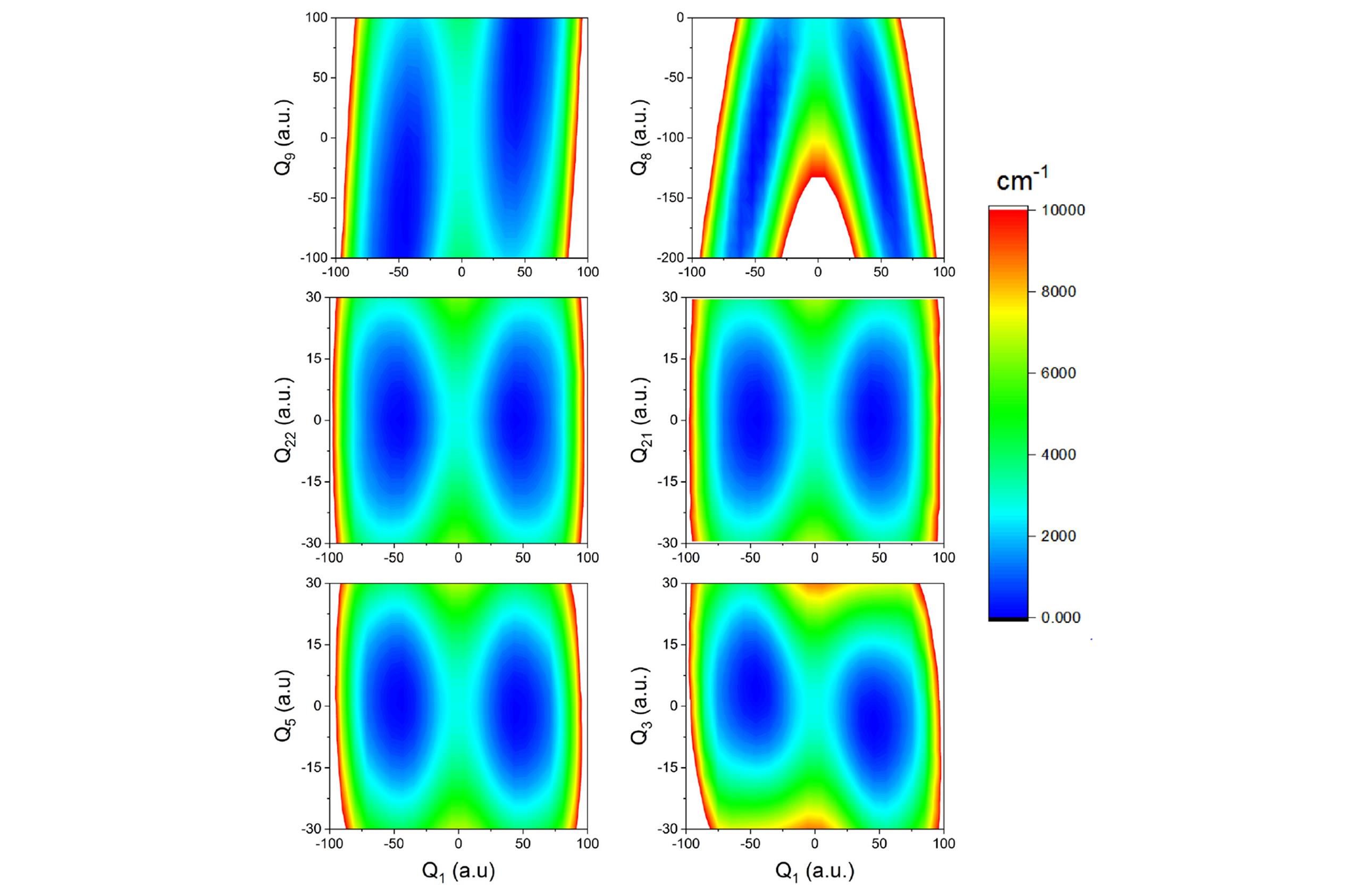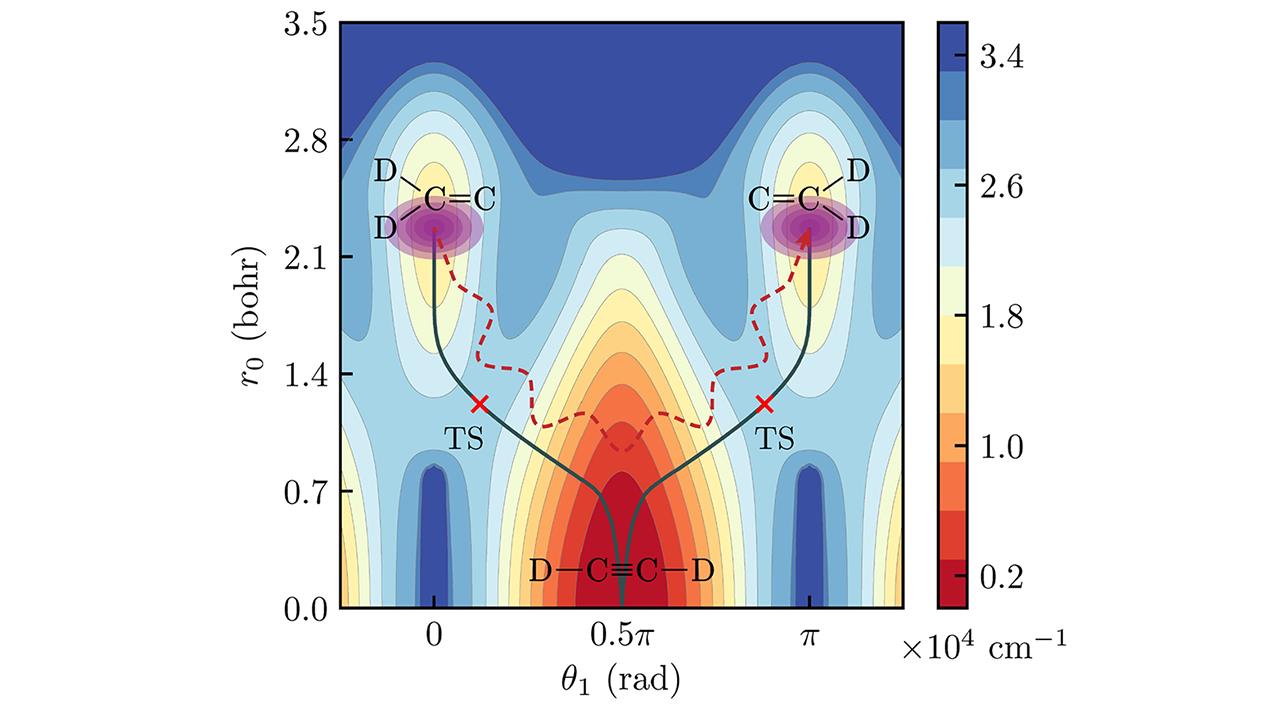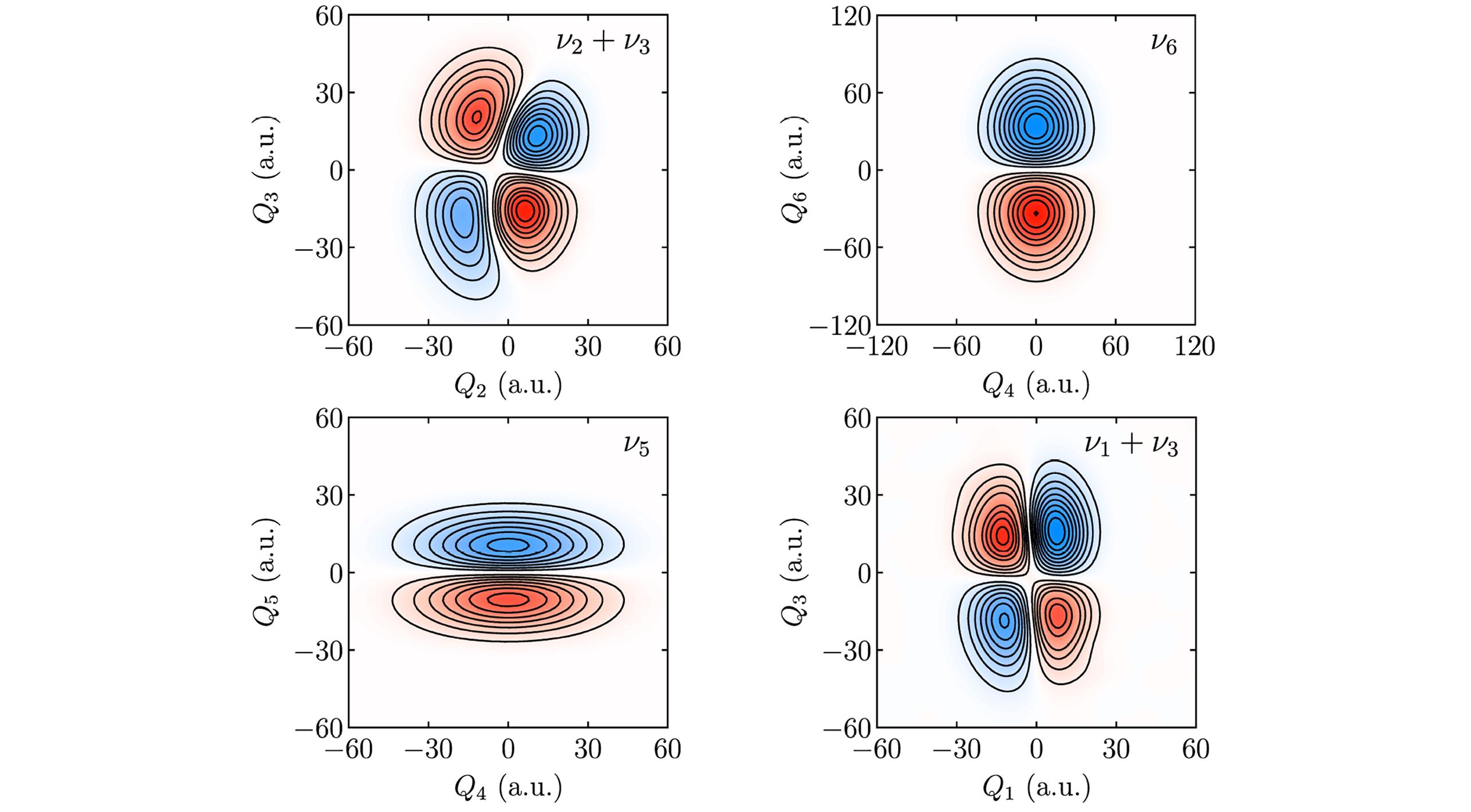

Chem. J. Chinese Universities ›› 2021, Vol. 42 ›› Issue (7): 2123.doi: 10.7503/cjcu20210129
• Review • Previous Articles Next Articles
BIAN Wensheng1,2( ), CAO Jianwei1
), CAO Jianwei1
Received:2021-03-01
Online:2021-07-10
Published:2021-04-30
Contact:
BIAN Wensheng
E-mail:bian@iccas.ac.cn
Supported by:CLC Number:
TrendMD:
BIAN Wensheng, CAO Jianwei. The PBFC-PI Quantum Dynamical Method and Its Applications[J]. Chem. J. Chinese Universities, 2021, 42(7): 2123.

Fig.1 Schematic potential energy profile along the H?transfer path in the formic acid dimer, with the tunneling for both the vibrational ground? and excited?states indicated[15]

Fig.3 Contour plots of the 2D effective potentials as functions of normal coordinates Q1 and Qi (i=9, 8, 22, 21, 5, 3)[15]The contours are in cm-1 and relative to the global minimum. Copyright 2020, American Chemical Society.

Fig.5 A typical cut through the 4D effective potential for vinylidene?d2 isomerization[17]Potential contours are plotted using the Jacobi coordinates with θ2 and ? fixed at 0.5π and 0, respectively.Copyright 2020, American Institute of Physics.

Fig.7 Wavefunction contour plots of the selected vinylidene?d2 states against the relevant normal mode coordinates(Qi), with the other coordinates fixed at zero[17]Copyright 2020, American Institute of Physics.
| 43 | Zou S., Bowman J. M., Chem. Phys. Lett., 2003, 368, 421—424 |
| 44 | Shen Z., Ma H., Zhang C., Fu M., Wu Y., Bian W., Cao J., Nat. Commun., 2017, 8, 14094 |
| 45 | Zhang C., Fu M., Shen Z., Ma H., Bian W., J. Chem. Phys., 2014, 140, 234301 |
| 46 | Wu Y., Zhang C., Cao J., Bian W., J. Phys. Chem. A, 2014, 118, 4235—4242 |
| 47 | Shen Z., Cao J., Bian W., J. Chem. Phys., 2015, 142, 164309 |
| 48 | Wu Y., Cao J., Bian W., J. Phys. Chem. A, 2020, 124, 801—809 |
| 49 | Liu X., Bian W., Zhao X., Tao X., J. Chem. Phys., 2006, 125, 074306 |
| 50 | Nanbu S., Aoyagi M., Kamisaka H., Nakamura H., Bian W., Tanaka K., J. Theor. Comput. Chem., 2002, 01, 263—273 |
| 51 | Yu L., Bian W., J. Comput. Chem., 2011, 32, 1577—1588 |
| 52 | Yu L., Bian W., J. Chem. Phys., 2012, 137, 014313 |
| 53 | Fu M., Ma H., Cao J., Bian W., J. Chem. Phys., 2016, 144, 184302 |
| 54 | Wang Y., Braams B. J., Bowman J. M., Carter S., Tew D. P., J. Chem. Phys., 2008, 128, 224314 |
| 55 | Qu C., Bowman J. M., Phys. Chem. Chem. Phys., 2016, 18, 24835—24840 |
| 56 | Cao J., Zhang Z., Zhang C., Liu K., Wang M., Bian W., Proc. Natl. Acad. Sci. U.S.A., 2009, 106, 13180—13185 |
| 57 | Wang M., Sun X., Bian W., Cai Z., J. Chem. Phys., 2006, 124, 234311 |
| 58 | Wang M., Sun X., Bian W., J. Chem. Phys., 2008, 129, 084309 |
| 59 | Jing F., Cao J., Liu X., Hu Y., Ma H., Bian W., Chin. J. Chem. Phys., 2016, 29, 430—436 |
| 60 | Goroya K. G., Zhu Y., Sun P., Duan C., J. Chem. Phys., 2014, 140,164311 |
| 61 | Zhang Y., Li W., Luo W., Zhu Y., Duan C., J. Chem. Phys., 2017, 146, 244306 |
| 62 | Li W., Evangelisti L., Gou Q., Caminati W., Meyer R., Angew. Chem. Int. Ed., 2019, 58, 859—865 |
| 63 | Daly A. M., Douglass K. O., Sarkozy L. C., Neill J. L., Muckle M. T., Zaleski D. P., Pate B. H., Kukolich S. G., J. Chem. Phys., 2011, 135, 154304 |
| 64 | Ortlieb M., Havenith M., J. Phys. Chem. A, 2007, 111, 7355—7363 |
| 65 | Smedarchina Z., Siebrand W., Fernández⁃Ramos A., J. Phys. Chem. A, 2013, 117, 11086—11100 |
| 66 | Richardson J. O., Phys. Chem. Chem. Phys., 2017, 19, 966—970 |
| 67 | Jain A., Sibert E. L., J. Chem. Phys., 2015, 142, 084115 |
| 68 | Levin J., Feldman H., Baer A., Ben⁃Hamu D., Heber O., Zajfman D., Vager Z., Phys. Rev. Lett., 1998, 81, 3347—3350 |
| 69 | Schork R., Köppel H., J. Chem. Phys., 2001, 115, 7907—7923 |
| 70 | Bittner M., Köppel H., Phys. Chem. Chem. Phys., 2003, 5, 4604—4611 |
| 71 | Srivastava H. K., Conjusteau A., Mabuchi H., Callegari A., Lehmann K. K., Scoles G., Silva M. L., Field R. W., J. Chem. Phys., 2000, 113, 7376—7383 |
| 72 | DeVine J. A., Weichman M. L., Xie C., Babin M. C., Johnson M. A., Ma J., Guo H., Neumark D. M., J. Phys. Chem. Lett., 2018, 9, 1058—1063 |
| 73 | Kozin I. N., Law M. M., Tennyson J., Hutson J. M., J. Chem. Phys., 2005, 122, 064309 |
| 74 | Tremblay J. C., Carrington T., J. Chem. Phys., 2006, 125, 094311 |
| 75 | Li B., Bian W., J. Chem. Phys., 2008, 129, 024111 |
| 76 | Germann T. C., Miller W. H., J. Chem. Phys., 1998, 109, 94—101 |
| 77 | Ervin K. M., Ho J., Lineberger W. C., J. Chem. Phys., 1989, 91, 5974—5992 |
| 1 | Leclerc A., Carrington T., J.Chem. Phys., 2014, 140, 174111 |
| 2 | Wang X., Carter S., Bowman J. M., J. Phys. Chem. A, 2015, 119, 11632—11640 |
| 3 | Wu F., Ren Y., Bian W., J. Chem. Phys., 2016, 145, 074309 |
| 4 | Thomas P. S., Carrington T., J. Phys. Chem. A, 2015, 119, 13074—13091 |
| 5 | Ren Y., Bian W., J. Phys. Chem. Lett., 2015, 6, 1824—1829 |
| 6 | Schröder M., Meyer H. D., J. Chem. Phys., 2014, 141, 034116 |
| 7 | Hammer T., Manthe U., J. Chem. Phys., 2011, 134, 224305 |
| 8 | Bian W., Deng C., Int. J. Quantum Chem., 1994, 51, 285—291 |
| 9 | Bian W., Deng C., Theor. Chem. Acc., 1997, 98, 110—116 |
| 10 | Homayoon Z., Bowman J. M., Evangelista F. A., J. Phys. Chem. Lett., 2014, 5, 2723—2727 |
| 11 | Richardson J. O., Althorpe S. C., J. Chem. Phys., 2011, 134, 054109 |
| 12 | Richardson J. O., Wales D. J., Althorpe S. C., McLaughlin R. P., Viant M. R., Shih O., Saykally R. J., J. Phys. Chem. A, 2013, 117, 6960—6966 |
| 13 | Makri N., Miller W. H., J. Chem. Phys., 1989, 91, 4026—4036 |
| 14 | Wang Y., Bowman J. M., J. Chem. Phys., 2013, 139, 154303 |
| 15 | Liu H., Cao J., Bian W., J. Phys. Chem. A, 2020, 124, 6536—6543 |
| 16 | Liu H., Cao J., Bian W., Front. Chem., 2019, 7, 676 |
| 17 | Luo J., Cao J., Liu H., Bian W., J. Chem. Phys., 2020, 153, 054309 |
| 18 | DeVine J. A., Weichman M. L., Laws B., Chang J., Babin M. C., Balerdi G., Xie C., Malbon C. L., Lineberger W. C., Yarkony D. R., Field R. W., Gibson S. T., Ma J., Guo H., Neumark D. M., Science, 2017, 358, 336—339 |
| 19 | Bian W., Deng C., Int. J. Quantum Chem., 1994, 50, 395—400 |
| 20 | Ren Y., Li B., Bian W., Phys. Chem. Chem. Phys., 2011, 13, 2052—2061 |
| 21 | Ren Y., Li B., Bian W., AIP Conf. Proc., 2012, 1504, 921—924 |
| 22 | Harris D. O., Engerholm G. G., Gwinn W. D., J. Chem. Phys., 1965, 43, 1515—1517 |
| 23 | Light J. C., Carrington T., Adv. Chem. Phys., 2000, 114, 263—310 |
| 24 | Bramley M. J., Carrington T., J. Chem. Phys., 1993, 99, 8519—8541 |
| 25 | Bačić Z., Light J. C., J. Chem. Phys., 1986, 85, 4594—4604 |
| 26 | Light J. C., Bačić Z., J. Chem. Phys., 1987, 87, 4008—4019 |
| 27 | Echave J., Clary D. C., Chem. Phys. Lett., 1992, 190, 225—230 |
| 28 | Wei H., Carrington T., J. Chem. Phys., 1992, 97, 3029—3037 |
| 29 | Lee H. S., Light J. C., J. Chem. Phys., 2004, 120, 4626—4637 |
| 30 | Zou S., Bowman J. M., Brown A., J. Chem. Phys., 2003, 118, 10012—10023 |
| 31 | Zou S., Bowman J. M., J. Chem. Phys., 2002, 117, 5507—5510 |
| 32 | Huang S. W., Carrington T., J. Chem. Phys., 2000, 112, 8765—8771 |
| 33 | Poirier B., Carrington T., J. Chem. Phys., 2001, 114, 9254—9264 |
| 34 | Poirier B., Carrington T., J. Chem. Phys., 2002, 116, 1215—1227 |
| 35 | Wyatt R. E., Phys. Rev. E, 1995, 51, 3643—3658 |
| 36 | Li B., Ren Y., Bian W., ChemPhysChem, 2011, 12, 2419—2422 |
| 37 | Zhang Z., Li B., Shen Z., Ren Y., Bian W., Chem. Phys., 2012, 400, 1—7 |
| 38 | Bian W., Poirier B., J. Theor. Comput. Chem., 2003, 2, 583—597 |
| 39 | Bian W., Poirier B., J. Chem. Phys., 2004, 121, 4467—4478 |
| 40 | Zhang C., Ma H., Bian W., Prog. Chem., 2012, 24, 1082—1093 |
| 41 | Cao J., Li F., Xia W., Bian W., Chin. J. Chem. Phys., 2019, 32, 157—166 |
| 42 | Wu Y., Cao J., Ma H., Zhang C., Bian W., Nunez⁃Reyes D., Hickson K. M., Sci. Adv., 2019, 5, eaaw0446 |
| [1] | AN Feng, HU Xixi, XIE Daiqian. Research Advances on Nonadiabatic Energy Transfer Dynamics for Triatomic Molecules [J]. Chem. J. Chinese Universities, 2021, 42(7): 2103. |
| [2] | LI Weitang, REN Jiajun, SHUAI Zhigang. Theory and Applications of Time Dependent Density Matrix Renormalization Group [J]. Chem. J. Chinese Universities, 2021, 42(7): 2085. |
| [3] | HU Xixi, YANG Junying, XIE Daiqian. State-to-state Quantum Dynamics of Reaction N+NH→N2+H [J]. Chem. J. Chinese Universities, 2015, 36(11): 2198. |
| Viewed | ||||||
|
Full text |
|
|||||
|
Abstract |
|
|||||